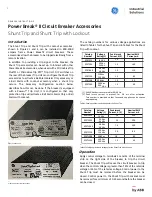
IB 6.2.11.1-1C
Page 10
ABB
and the control power source energized, the following
occurs when the motor disconnect switch is placed in
the ON position (Refer to the schematic on page 11):
1. The "b" contact (closed when the breaker is open)
and the CSCS contact (closed when the closing springs
are discharged), allow the spring charging motor to be
energized. When the closing springs reach the fully
charged condition, the CSCS opens to deenergize the
motor.
2. Operation of the remote close control switch or
optional electrical close push button energizes the
close coil through the Solid State Control Device
(SSCD) and the breaker auxiliary switch "b" contact.
The close coil releases the close latch, the springs
discharge, and the breaker contacts close.
3. When the springs discharge, the CSCS contacts
close.
4. When the circuit breaker contacts close, all auxiliary
switch “a" contacts close and all “b" contacts open.
5. With the local or remote close signal still applied, the
anti-pump feature of the SSCD “locks out” the close
coil. In doing so, the circuit breaker mechanism will not
pump should it close into a faulted circuit.
6. The circuit breaker can be tripped electrically by
operation of remote trip control or by operating the
optional local electric trip push button. When tripped in
this manner, the trip coil is energized through the
SSCD and the auxiliary switch "a" contact.
7. Tripping the circuit breaker opens the “a" contacts
and closes the “b” contacts. At that point, the motor
circuit is once again complete and the motor will charge
the closing springs.
CLOSING SPRING OPERATION (MO)
In one continuous downward pull of the handle the two
closing springs are charged, and near the end of the
stroke are discharged to fast close the circuit breaker.
During closing, the two opening springs are charged. If
so equipped, the breaker may be opened electrically by
energizing the optional shunt trip.
INSTALLATION, INITIAL TESTING, AND
REMOVAL
For Safety: When installing or removing the circuit
breaker for the first time, the primary and control
circuits should be deenergized. All tests of the circuit
breaker should be done with the circuit breaker in the
TEST position.
Installation
To insert the circuit breaker into its mating cubicle,
proceed as described below:
1. The circuit breaker contacts must be OPEN, and the
racking crank turned in the counterclockwise direction
fully against its stop. On electrically operated circuit
breakers, the motor disconnect switch should be in the
OFF position.
2. Open the compartment door and pull out the right
and left hand tracks to the full extended position (until
they snap into place with the retaining latches).
3. Using a lifting yoke, position the yoke so that it
captures the K-Line Plus circuit breaker as shown in
Figure 1. Using an overhead lifting device, raise and
install the circuit breaker by lowering it such that the
studs on either side of the circuit breaker rest in the
cutouts in the extended cradle rails. If the switchgear
does not have the overhead lifting device, an external
lifting device with capabilities for handling the circuit
breaker weight, and compartment height requirements,
is needed. In addition, this equipment must be
compatible with the lifting yoke. Use a hoist type of lift.
Do not attempt to raise the circuit breaker by any other
means, as damage to the circuit breaker can occur
rendering it unsatisfactory for service.
DO NOT USE
THE PRIMARY DISCONNECTS AS A LIFTING
POINT.
4. Remove the lifting yoke and push the circuit breaker
toward the compartment. The circuit breaker will slide
in the cut-out sections of the tracks until positioning
pins reach the end of the cutouts. Push down on the
side levers to release the two latches; this allows the
circuit breaker to move toward the compartment until
the racking cams stop against their guides in the
cradle. If mechanical interference occurs before the
circuit breaker reaches this point, recheck the cradle
and the ampere rating of the breaker to make sure they
match.
5. Lift the shutter covering the racking opening, insert
the racking crank, and turn the crank clockwise. Pass
through the DISCONNECTED position, until the
position indicator on the cradle (left side) shows TEST
position. Remove racking crank, and ensure that the
racking shutter closes completely.
Initial Testing
(Continued on page 13)
Содержание K-Line Plus KP-8
Страница 23: ...IB 6 2 11 1 1C Page 23 ABB NOTES ...
Страница 24: ...IB 6 2 11 1 1C Page 24 ABB NOTES ...
Страница 25: ...IB 6 2 11 1 1C Page 25 ABB NOTES ...



































